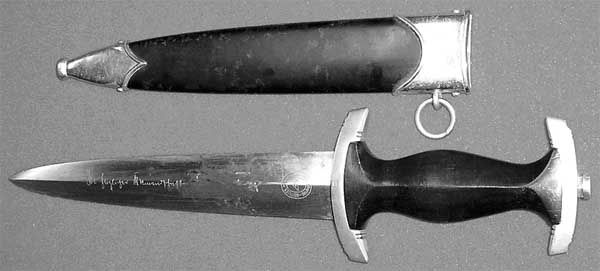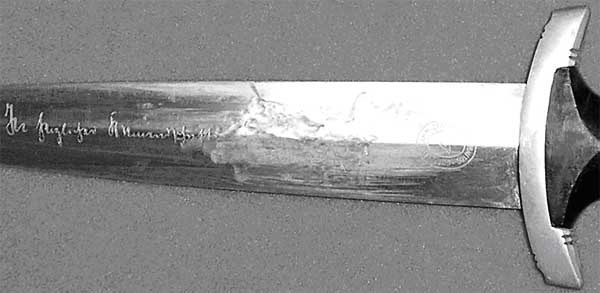| |
AN ERNST RÖHM HONOUR DAGGER |
|
| |
from the collection of |
|
| |
Kurt Mussiger |
|
| |
 |
|
| |
Adolph Hitler's rise to power during the early 1930's was largely facilitated by the Sturmabteilung or SA, an army of some four million storm-troopers known as the 'Brown-Shirts', commanded by Hitler's old comrade Ernst Röhm. By early 1934, however, the SA had become something of a liability to the Nazi regime, indulging in increasingly corrupt, lawless and immoral behaviour, and even plotting national socialist revolution on their own accord. Hitler soon found himself under pressure from industry leaders, regular army generals, and even the German president, Hindenburg, to bring the SA under control. At a meeting with Hitler in late February, Röhm reluctantly agreed to surrender military power to the German Army and signed a statement to that effect, but it soon became apparent that he intended to pursue his military ambitions in defiance of the agreement. |
|
|
|
|
| |
Within the SA, a highly-disciplined organisation known as the Shutzstaffel or SS, commanded by Heinrich Himmler, had been formed as Hitler's personal bodyguard. Sensing Röhm's vulnerability and hoping to gain from his downfall, Himmler, Heydrich and Göring plotted against him in June 1934, spreading false rumours of an imminent, violent coup d'état by the SA. Himmler had apparently made a secret agreement with the regular army generals to support the SS's uprising against the SA, by providing weapons and logistics but remaining in barracks and leaving all the action to the SS. On June 30 the SS began arresting SA officers and troops, and Hitler personally travelled to Bad Wiessee near Munich to confront Röhm, arresting him at gunpoint. Röhm and his men were sent immediately to Stadelheim Prison. |
|
|
|
|
| |
This action was referred to by Hitler himself as "the night of the long knives", during which several hundred SA officers and troops were rounded up and shot, and indeed Röhm must have spent an uncomfortable night listening to the firing squads executing his men outside his prison window. The next morning, on Hitler's orders Röhm was presented with a pistol containing a single cartridge and left alone in his cell, but after some 15 minutes or so he had refused to take his own life, at which point two SS officers entered the room and shot him point-blank in the chest. |
|
|
|
|
| |
In keeping with Nazi tradition, SA and SS Honour Daggers bearing loyalty
inscriptions on the blade were worn as a mark of allegiance. Some 9,900 personnel were authorised to wear the Model 1933 SS Honour Dagger bearing the words “In herzlicher freundschaft, Ernst Röhm” engraved in a facsimile of Röhm’s own handwriting (In heartfelt friendship, Ernst Röhm). During the purge that followed Röhm's death (known as Operation Hummingbird after the code-word 'Kolibri' used to initiate the action), all those possessing an SA or SS dagger bearing Röhm's name were instructed to have the inscription removed, and took whatever steps were available to erase the incriminating words from the blade. Some were polished off neatly, others were hastily ground off in desperation as the SS dragnet closed in. This dagger would appear to fall into the latter group! |
|
| |
 |
|
| |
Original Ernst Röhm SS Honour Daggers in unmutilated condition are extremely rare today and acquiring one of the few remaining examples would be a very difficult and expensive undertaking! |
|
| |
 |
|
| |
A comprehensive account of events leading up to 'The Night of the Long Knives' can be found on the internet at this address:
|
|
| |
|
|


